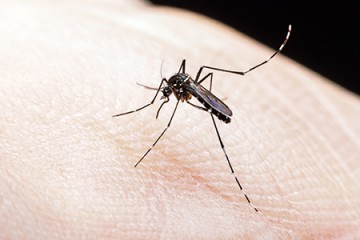Four teams of researchers from Johns Hopkins University—including three from the Johns Hopkins Bloomberg School of Public Health and another pursuing an idea that originated at a recent Zika hackathon at JHU—will be awarded grants from U.S. Agency for International Development's Combating Zika and Future Threats Grand Challenge, the agency announced today.
In what the agency is calling "potentially game-changing solutions to mitigate the spread and impact of the Zika virus," 21 grants totaling $15 million will be awarded for groundbreaking ideas from around the world to both address the current Zika outbreak and improve the ability to prevent, detect, and respond to future infectious disease outbreaks. In just nine weeks, USAID received nearly 900 submissions from across the globe in response to the Challenge, which will invest up to $30 million.
A complete list of grant recipients can be found on the USAID website. No other institution received more than two awards from USAID.
The research of Conor McMeniman, an assistant professor at the Johns Hopkins Malaria Research Institute at the Bloomberg School, will focus on what parts of human scent are attractive to Aedes aegypti, the mosquito that carries the Zika virus, as well as other viruses including dengue, chikungunya, and yellow fever. The goal is to mimic the scent of humans to develop a powerful lure that can be used as bait in mosquito traps in an effort to prevent mosquitoes from spreading diseases.
"Body odor and breath are made up of about 300 different chemicals, and we want to understand what part of the chemistry of human scent is most attractive to the mosquitoes that carry Zika," McMeniman says. "The goal is to develop a custom fragrance to bait mosquito traps and improve our ability to fight mosquito-borne illnesses."
To accomplish this, McMeniman and his team will use two-photon microscopy to see which of the chemicals of human scent activate the olfactory centers of the mosquito brain. Using mosquitoes that have been genetically engineered to have olfactory centers light up when they are activated, the researchers will literally look inside the brains of these tiny insects to understand how to create the best chemical lure.
McMeniman says better understanding how the mosquito nervous system detects humans will provide new avenues to control diseases spread by Aedes aegypti and other species, including the mosquitoes that carry malaria, which kills more than 500,000 people worldwide each year, mostly in young children in sub-Saharan Africa.
The current outbreak of Zika—a virus recently linked to brain-related birth defects in babies born to pregnant mothers who contract it—is most prevalent in Brazil, Colombia, Puerto Rico, and other parts of the Americas. More than 1,800 cases of Zika have been reported in the U.S., though most of those were contracted by people who had traveled outside the U.S. Recently, however, Zika-carrying mosquitoes were found in a small section of Miami, Florida, and health officials say nearly two dozen cases have now been reported in people who were infected domestically.
Current Zika control strategies are mainly based on the use of insecticides and personal mosquito repellents. But a continuous emergence of mosquito resistance to insecticides and the lack of drugs and vaccines for Zika and other mosquito-transmitted pathogens render the development of novel, cost-effective mosquito control strategies urgent, says George Dimopoulos, a professor at the Malaria Institute.
Dimopoulos' team has identified a new bacterium, Chromobacterium Csp_P, which can kill larvae and adults of various species of mosquito that transmit malaria, dengue, Zika, yellow fever, and West Nile virus. The bacterium also blocks the pathogens inside the mosquitoes, preventing infectious transmission in the mosquito gut.
"This can be a highly potent weapon against current and future mosquito-borne diseases," Dimopoulos says.
His team aims to develop Chromobacterium Csp_P into a cost-effective, environmentally-friendly, and logistically simple mosquito control biopesticide. Chromobacteria are abundant soil bacteria and have already been developed for agricultural pest control by live spraying on fields, but not for mosquito control. The end users of Chromobacterium Csp_P –based products could range from mosquito control organizations to individual households.
The third award will go to the Bloomberg School's Center for Communication Programs, or CCP. Researchers there note that changing household and community behaviors around the proper and consistent cleaning of standing water will be key to stopping Zika in its tracks. Mosquitoes breed in standing water.
Susan Krenn, executive director of CCP, says that rapid change of habits, attitudes, and behaviors is a challenging but critical component of disease containment. CCP will work with consulting firm Catalyst Behavioral Sciences to develop the Rapid SBCC Habit Optimization Tool, or R-SHOT, which will combine local data with evidence-based behavior change and habit formation principles to determine the best way to help people in communities impacted by Zika control the mosquito problem themselves.
"As we saw during the Ebola crisis, changes in habits and behavior can have substantial impact on the spread of disease," Krenn says. "To be successful, behavior change strategies for Zika will need to be tailored to local contexts and leverage existing behaviors and habits."
The final funded project, known as VectorWEB, would improve upon the existing approach to mosquito population surveillance. Currently, ovitraps—designed to kill adult breeding mosquitos—are placed in the field, then later collected, and the number of mosquitoes in each trap is counted manually in a lab.
A team led by Soumyadipta Acharya, an assistant professor in JHU's Department of Biomedical Engineering, has proposed a modified trap that would have the ability to provide real-time data to health administrators, community health workers, and others. That data could then be used for outbreak modeling, targeted resource allocation and redirection, and community-driven public health interventions.
The VectorWEB project is the result of a collaboration between the Center for Bioengineering Innovation and Design, a center within the Department of Biomedical Engineering shared by the Whiting School of Engineering and the School of Medicine, and Jhpiego, a university-affiliated global health nonprofit.
Several VectorWEB teammates have been working on the project since a spring hackathon sponsored by CBID and Jhpiego to meet the daunting public health challenges presented by the Zika outbreak. The hackathon drew more than 60 participants for a weekend of problem-solving and development of innovative, creative, low-cost design solutions.
Posted in Health
Tagged epidemiology, jhpiego, infectious disease, zika virus











